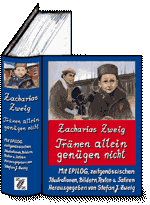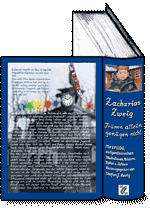Foreword
by Heinz Strotzka, Salzburg
The fate of Dr. Zacharias Zweig and his son Stefan Jerzy is beyond imagining. It was hardly possible for an adult to survive the tortures of a concentration camp. What chances of survival, then, did a little child have? The added worry about his son must have been well-nigh unbearable for Dr. Zweig. What happened to the Zweig family is paradigmatic for the suffering endured by so many. The immediate family, consisting of Dr. Zweig, his wife Helena, their daughter Silvia (born in 1932) and their son Stefan Jerzy (born in 1941) first had to move to the Cracow Ghetto. After spending long periods in the concentration camps of Biezanov, Skarzysko-Kamienna and Plaszow, the Zweig family was put on a transport destined for Buchenwald.
Helena Zweig and her daughter were incarcerated in a satellite camp of Buchenwald and were subsequently deported to Auschwitz, where they were murdered in the gas chambers. Helena’s son Jerzy was only able to survive thanks to the extraordinary protectiveness of political prisoners at Buchenwald, who saw in this protection an act of resistance and wanted thereby to set an example of humanity.
After liberation, Zacharias Zweig returned with his son to Cracow, travelling on later to France before finally settling in Israel in 1949. Because the legal system in Israel was different to that in Poland, Dr. Zweig was unable to continue in his previous profession as a lawyer. Until his retirement, he worked as an official in the Israeli Finance Ministry. His main concern was for his son, with whom he lived together in very cramped accommodation. Stefan had quickly learnt the languages of the various countries he had been in. In 1959, he completed his schooling in Israel and began his military service. In the meantime, Dr. Zweig was able to establish contact to those former prisoners who had done so much to save his son’s life.
It was in 1958, in the German Democratic Republic, that Bruno Apitz’s novel „Naked Among Wolves“ was first published – a novel which, give and take a few changes, depicts the fate and rescue of a child at Buchenwald concentration camp on the basis of an authentic case. After some research, the GDR was able to establish the whereabouts of those represented in the novel’s main figures.
Willi Bleicher, one of the rescuers, had since become Chairman of the Metalworkers’ Union in Baden-Wurttemberg, and he immediately took up contact with Stefan Jerzy Zweig, who by now had grown into a young man. There followed a communal visit to the former concentration camp at Buchenwald, in which Robert Siewert, another of Stefan’s rescuers, also participated.
Stefan Jerzy Zweig was offered the chance to study in the GDR, which he initially turned down. But then he decided after all to opt to study at the Filmhochschule in Berlin-Babelsberg. In 1972 he left the GDR and moved with his family to Vienna. There he took a position as cameraman for Austrian Television (ORF). His father died in 1972 in Tel Aviv. In 1961, Zacharias Zweig had written a detailed report of his time in the concentration camps, which makes up the first part of the present book. No less significant are the memories of his son, which Stefan himself describes as an „epilogue“. In this epilogue, Stefan Zweig candidly portrays his own life, which was overshadowed constantly by the experiences of his early childhood. The „fame“ which he acquired as a result of having provided the inspiration for the boy in „Naked Among Wolves“ was without doubt a further burden which he had to bear.
The present book, however, also has another purpose. Seen from the perspective of a victim, the new management of Buchenwald Memorial Site come in for sharp criticism.
The de facto equation of the victims of fascism with those people who were interned in Buchenwald after 1945 can only be a source of great indignation for the former. The group classified as „victims of Stalinism“ was very heterogeneous and included war criminals, Nazi functionaries as well as critics of the occupying Soviet powers and of the political system they imposed in eastern Germany. The totalitarian theory which underpins such an equation necessarily leads to false analogies and to a relativisation of National Socialist crimes. Moreover, the denunciation of the communist prisoners as "Stalinists" does not do justice to this group of people and has repeatedly met with vigorous objections from those affected.
As a result of the emphatic protest raised by Stefan J. Zweig against personal insinuations and attacks by the head of the memorial site, Dr. Knigge, the director ordered the removal of a wall plaque at the memorial site which provided information on Buchenwald’s youngest prisoner.
In addition, the curatorium with Dr. Knigge at its head started up a polemic about the conduct of former prisoners. Basically, his theory focused on everything Buchenwald’s prisoners should or should not have done during the war and afterwards. Curiously, not one of these prisoners was ever allowed to join this curatorium.
By contrast, the theme of the evil cancer of the National Socialist system is today very much pushed into the background and is represented only fragmentarily; as a result, the historical connections are hard for young visitors to understand.
The documentation in this volume, together with the life-story of Stefan Jerzy Zweig, are authentic proof of the effects of one of the most monstrous crimes in human history. But they also provide evidence of deep humanity, a humanity which found expression under the most unimaginable of conditions.
Heinz Strotzka, Salzburg
former chairman of the conference for historical didactics
Translated by Bill Nive

